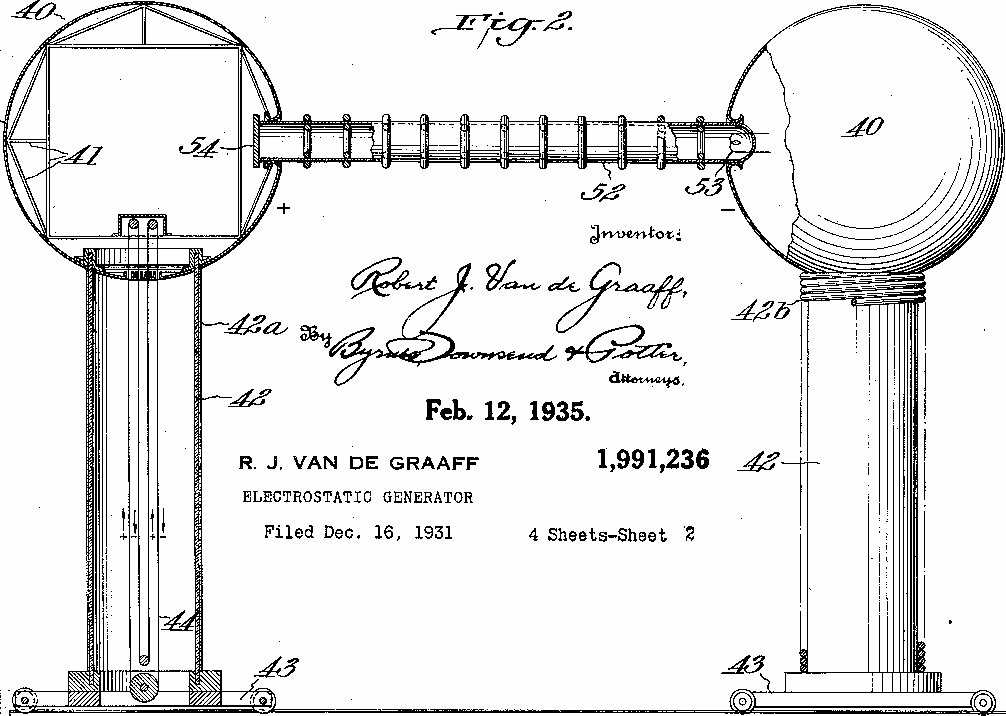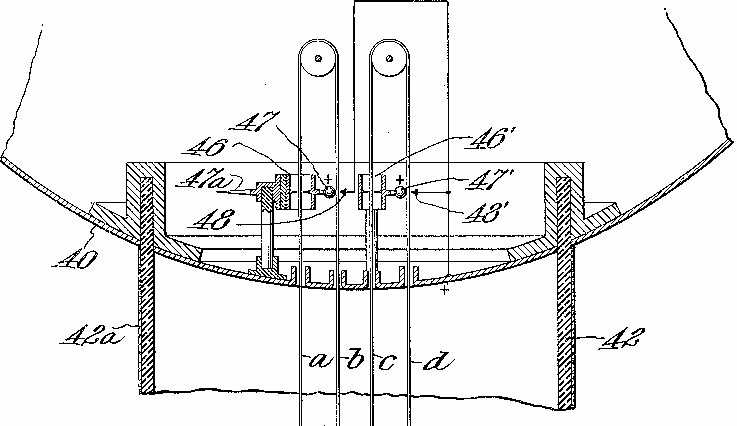
Oft Overlooked Innovations
Within Van de Graaff`s
Original Patent of 1935
|
A feebly conductive coating on the supporting column overcomes corona leakage at opening of sphere, & possibility of replacing charge transport belt with pumped insulating fluid
"A generator system operative to produce voltages
of the order of several million volts is illustrated
in Fig. 2. For convenience of description,
it will be assumed that a maximum voltage of
about 10,000,000 volts is to be produced between
the spherical electrodes 40, i. e., a potential difference
of about 5,000,000 volts between each
electrode and ground."

"The electrodes take the
form of a thin conducting shell 40 that is supported
by an interior framework 41, the conducting
shell being free from surface irregularities or
projections and having a diameter of about 10
feet. The insulator columns 42 which support the
electrodes 40 on the movable bases 43 may be
tubular sleeves of non-conducting material, for
example, paper or wood veneer impregnated with
shellac or an artificial resin. Adequate insulation
will be provided when the insulator columns
have a length of about fifteen feet.
To insure most efficient operation it is highly
desirable to maintain a uniform potential gradient
between the electrode and ground along the
supporting column 42. This condition will obtain
when the insulating support presents high
conductivity in horizontal planes and a controlled
resistance in vertical planes along the column.
By providing a conductive coating upon the surface
of the column, the coating being of substantially
constant but relatively low conductivity,
the leakage flow of current will establish a uniform
potential gradient along the column and,
since the potential will be substantially constant
over any horizontal plane, the lines of force in
the space within the column will be substantially
linear and parallel to the axis of the column."

"This leakage coating may take the form of a
paint or varnish layer 42a, of low conductivity,
as shown in Fig. 3 and at the left of Fig. 2, or it
may comprise a cord or thread 42b that is rendered
slightly conductive by treatment with
graphite or India ink, and is wound spirally
around the column 42, as shown at the right of
Fig. 2.
The gradual potential gradient down the insulating
column tends likewise to produce a lowering
of the electric field at points on the spherical
electrode adjacent the entering portion of the
column 42, thus resulting in the location of the
most concentrated electric field at a region of
the electrode remote from the supporting column."

"As shown in Figs. 5 and 6, the charge carrier
is a fluid medium, such as oil, circulated through
the endless pipe line 64 by a pump 65. The fluid
medium is charged, at the lower portion of the
system, by a discharge point 66 which extends
into the conduit 64 and terminates adjacent the
larger and rounded electrode 67. Condenser
plates 68 are arranged within a portion of the
conduit 64 which lies within the hollow electrode
69, and washers or baffles 70 compel the moving
column of oil to flow between the condenser
plates. The condenser is charged by a current
source of low voltage, such as a battery 71 of
the low current drain type commonly used with
vacuum tubes as a plate battery, the battery being
connected between one condenser plate and
the electrode 69, while the other plate is
connected directly to the electrode.
With this arrangement, the moving column of
a fluid non-conducting medium receives electrical
charges as it passes the pointed electrode 66,
and the charges are removed and transferred to
the electrode as the medium passes between the
condenser plates. If desired, the fluid medium
may have fine particles suspended therein to act
as the charge carriers, but this is not generally
necessary as the charges may be applied directly
to the non-conducting fluid. The fluid may be
a liquid or a gas or vapor, or a mixture."
From Patent 1991236 R.J.Van de Graaff 1935
A convential re-entrant, belt Van de Graaff generator




